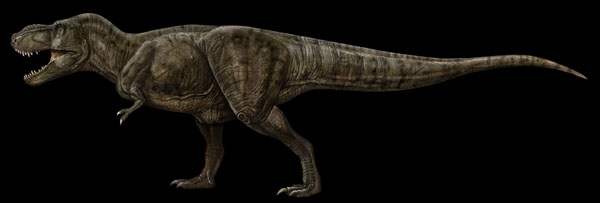Paleontologists from Institute of Vertebrate Paleontology and Paleoanthropology (IVPP), Chinese Academy, have just announced the discovery of Zhuchengtyrannus magnus, a.k.a. "Tyrant from Zhucheng," which was not only one of the world's largest carnivorous dinosaurs, but it also was a cousin of Tyrannosaurus rex. According to the findings, the newly named dinosaur species "Zhuchengtyrannus magnus" probably measured about 11 metres long, stood about 4 metres tall, and weighed close to 6 tonnes.
This "Tyrant" dino was unearthed in the city of Zhucheng, Shandong Province, eastern China, and is described in the latest issue of the journal Cretaceous Research. Its remains consist of a fossilized skull and jaw bones. In life, as you can see from the drawing, this meat lover sported a mouth full of very sharp teeth, the better to bite into its victims.
Alongside T. rex and the Asian Tarbosaurus, Zhuchengtyrannus magnus is one of a specialised group of gigantic theropods called tyrannosaurines. The tyrannosaurines existed in North America and eastern Asia during the Late Cretaceous Period, which lasted from about 99 to 65 million years ago. The tyrannosaurines were characterised by small arms, two-fingered hands, and large powerful jaws that could have delivered a powerful bone-crushing bite. They were likely both predators and scavengers.
The lead author, Dr David Hone, a postdoc fellow who worked with Professor XU Xing at Institute of Vertebrate Paleontology and Paleoanthropology, Chinese Academy of Sciences, currently holding a research position at the University College Dublin School of Biology and Environmental Science, explained, "Zhuchengtyrannus can be distinguished from other tyrannosaurines by a combination of unique features in the skull not seen in any other theropod", "With only some skull and jaw bones to work with, it is difficult to precisely gauge the overall size of this animal, but the bones we have are just a few centimetres smaller than the equivalent ones in the largest T. rex specimen. So there is no doubt that Zhuchengtyrannus was a huge tyrannosaurine.”
Together with nearby sites, the quarry in Shandong Province, eastern China where the remains of this huge carnivore were found contains one of the largest concentrations of dinosaur bones in the world.

Fig.1: Reconstruction of Zhuchengtyrannus magnus (By ZHAO Chuang, Courtesey of Xu Xing)
